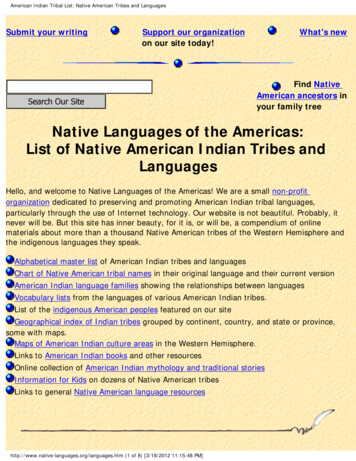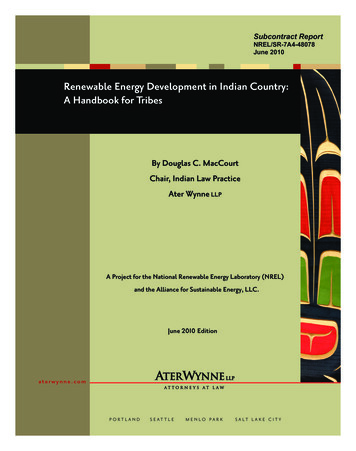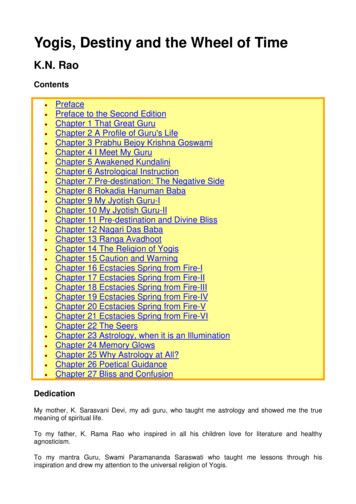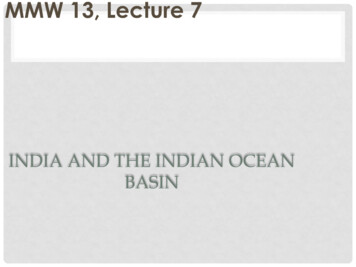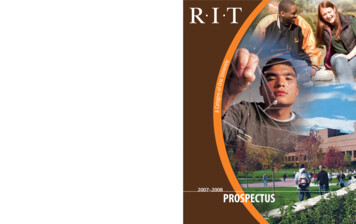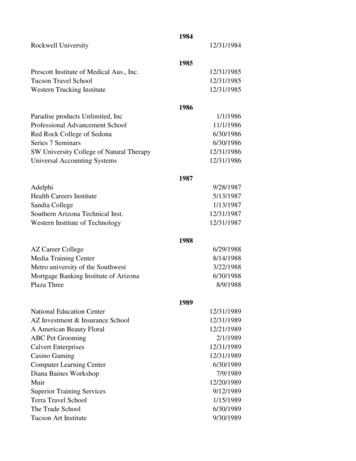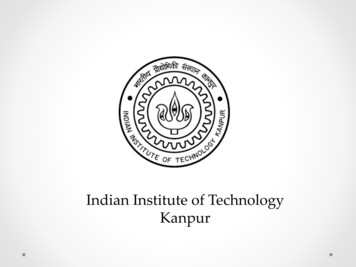
Transcription
Indian Institute of TechnologyKanpur
In Collaborationwith
National Program on TechnologyEnhanced Learning (NPTEL)
Presents
Course Title:Basic Cognitive ProcessesBy: Dr. Ark Verma,Assistant Professor of Psychology,Department of Humanities & Social Sciences,IIT Kanpur
Lecture 24: AOention-I
Some Key Questions Is it possible to selectively focus on one object/event,while many others are simultaneously going on? If yes, then under what conditions? What does research on aOention tell us about multi –tasking? Is it that we are not aOending to all other informationthat we are not focusing on?
Preliminary Definitions A"ention: the ability to focus on specific stimuli or spatiallocations. Selective A"ention: focusing aOention on a specific object,event or location. Overt A"ention: the process of shifting aOention from oneplace to another by moving of eyes to those specificobjects or locations.
Covert A"ention: when aOention is shifted without theactual movement of the eyes. Divided A"ention: the ability of aOending two objects atthe same time.
Image Source: Goldstein (2011). Cognitive Psychology Connecting Mind, research & Eveyday Experience.Cengage Learning
AOentional Processes: VisualSearch Search refers to our behaviour of scanning theenvironment looking for particular features – i.e. activelylooking for something when one is not aware of thelocation it will appear. Search becomes more difficult by distracters, i.e. non –target stimuli that divert our aOention away from thetarget stimulus.o False alarms usually arise when we encounter suchdistracters while looking for the target stimulus. for e.g.counterfeits.
the number of targets & distracters affects the difficultyof the task.o e.g. try to find T in the two figures, Panel A & B An interesting finding is the display size (i.e. the numberof items in a given visual array) effect, which is thedegree to which the number of items in a display hindersthe search process).
Image Source: Sternberg & Sternberg (2011). Cognitive Psychology. Wadsworth Publishing. 6th Ed. (p. 143).
Distracters cause more trouble under some conditionsthan under others.o we conduct a feature search, when we simply scan theenvironment for a specific feature (Treisman, 1993).Distracters play liOle role in slowing our search in thiscase. for example, finding O in the panel c. because O has a distinctive form as compared to the restof the items in the display; it pops out. Features singletons, i.e. items with distinctive featuresstand out in the display (Yantis, 1993); when featuresingletons are targets, they seem to grab our aOention;even those that may be distracting.
Image Source: Sternberg & Sternberg (2011). Cognitive Psychology. Wadsworth Publishing. 6th Ed. (p. 144).
on the other hand, when the target stimulus has nounique or even distinctive features. In these situations, the only way we can find such itemsis by conjunction search, i.e. we look for a particularcombination (conjunction) of features. for e.g. the onlydifference between a T & a L is the particular integrationof line segments. Both leOers comprise a horizontal lineand a vertical line. The dorsolateral prefrontal cortex as well as both frontaleye fields & the posterior parietal cortex play a role onlyin conjunction searches, but not so in feature searches(Kalla et el., 2009).
Theories of Visual Searcho Feature - Integration Theory explains the relative ease ofconducting feature searches and the relative difficulty ofconducting conjunction searches.o Going by Treisman's (1986) model of visual search, foreach possible feature of a stimulus, each of us has a mentalmap for representing the given feature across the visualfield. Say, there is a map for every colour, size, shape ororientation. there is no added time required for additionalcognitive processing. Thus during feature searchers, wemonitor the relevant feature map for the presence of anyactivation anywhere in the visual field.o This monitoring process can be done in parallel (all atonce). This will therefore show no display size effects.
However, during conjunction searchers; an additionalstage of processing is needed. During this stage, we mustuse our aOentional resources as a sort of mental glue;where in the two or more features are conjoined into anobject representation at a particular location. In thisstage, we can conjoin the features representation of onlyone object at a time. This stage, must be carried outsequentially, conjoining each object one by one. Effects ofdisplay size (i.e. a larger number of objects with featuresto be conjoined) therefore appear.
Such a model of visual search is supported by the work ofHubel & Wiesel, (1979), who identified specific neural featuredetectors.o these are cortical neurons that respond differentially to visualstimuli of particular orientations (e.g. vertical, horizontal, ordiagonal). More recent research has indicated that the best searchstrategy is not for the brain to increase the activity of neuronsthat respond to the particular target stimuli; in fact the brainseems to use the more nearly optimal strategy of activatingneurons that best distinguish the targets from the distracters,while at the same time ignoring the neurons that are tunedbest to the target (Navalpakkam & IOy, 2007).
Similarity Theory: According to similarity theory,Treisman’s data can be reinterpreted; as being a result ofthe fact that as the similarity between target & distracterstimuli increases, so does the difficulty in detecting thetarget stimuli (Duncan & Humphreys, 1992). Thus targets that are highly similar to distracters arerelatively harder to detect. Targets that are highlydisparate from distracters are relatively easy to detect.(e.g. finding the black circle in panel E).
Image Source: Sternberg & Sternberg (2011). Cognitive Psychology. Wadsworth Publishing. 6th Ed. (p. 146).
The target is highly similar to the distracters (blacksquares or white circles); therefore it is very difficult tofind. Further, the difficulty of search tasks depends upon thethe degree of disparity among the distracters; but it doesnot depend on the number of features to be integrated.for instance, one reason it is easier to read long strings oftext wriOen in lower case leOers than text wriOen incapital leOers is that capital leOers tend to be moresimilar to one another in appearance. Lowercase leOers,in contrast, have more distinguishing features. e.g. try tofind R in panels F & G.
Image Source: Sternberg & Sternberg (2011). Cognitive Psychology. Wadsworth Publishing. 6th Ed. (p. 146).
Guided Search Theory: An alternative to Treisman’smodel is offered as the guided search theory (Cave &Wolfe, 1990; Wolfe, 2007). The guided search model suggests that all searches,whether feature searchers or conjunction searchersinvolve two consecutive stage. The first is a parallelstage: the individual simultaneously activates a mentalrepresentation of all the potential targets. Therepresentation is based on the simultaneous activation ofeach of the features of the target. In a subsequent serial stage, the individual sequentiallyevaluates each of the activated elements, according to thedegree of activation. After that, the person chooses thetrue targets from the activated elements.
Acc. to this model, the activation process of the parallelinitial stage helps to guide the evaluation and theselection process of the serial second stage of the search.o For example; try to find the black circle in panel H. the parallel stage will activate a mental map that contains allthe features of the target (circle, black). Thus black circles,white circles & black squares will be activated. during the serial stage, one will first evaluate the black circle,which was highly activated. You will also evaluate the blacksquares & white circles as they are less activated & dismissthem as distracters.
Image Source: Sternberg & Sternberg (2011). Cognitive Psychology. Wadsworth Publishing. 6th Ed. (p. 147).
To Sum Up
References Sternberg & Sternberg (2011). Cognitive PsychologyWadsworth Publishing. 6th Ed.
Cognitive Psychology_Connecting Mind, research & Eveyday Experience. Cengage Learning. AOentional Processes: Visual Search . Cognitive Psychology. Wadsworth Publishing. 6th Ed. (p. 147). To Sum Up References Sternberg & Sternberg (2011). Cognitive Psychology Wadsworth P
